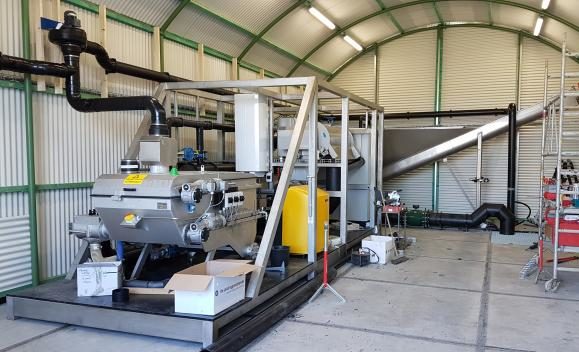Article at nu.nl: Thanks to this company there are bike paths with used toilet paper
That there is money to be made with used toilet paper is not very obvious. Nevertheless, CirTec from Purmerend proves that it is possible: the technology company has recently extracted four hundred kilos of cellulose per day from sewage water. It is used, among other things, for the construction of bicycle paths.
The fact that so much cellulose (raw material from toilet paper) can be extracted from sewage water did not exist at CirTec in the first instance either, says technical director Coos Wessels to NU.nl.
“In 2009 the water boards came up with the idea of sieving sewage water, because that way you can save money and energy and have to dispose of less sludge. They can not do that themselves, so we started working as a commercial party. The sieved material was placed under the microscope and it turned out that there was a lot of cellulose in it. “

“It will surprise you where cellulose can all be used for,” Wessels continues. “For asphalt, as insulation material, in fiberglass, in dishcloths, as raw material for chemicals. What surprised me personally was that the toilet paper we use in the Netherlands is of such high quality. I was always under the impression that it was paper that had already been used ten times. “
After pilots where a cycle path and an asphalt strip were constructed from asphalt with recycled cellulose, in Geestmerambacht an installation was installed by CirTec with the help of the North Holland water board HHNK. “The first in the world”, says Wessels. “Every day, four hundred kilos of cellulose comes from that goes to different customers. That seems like a lot, but you have to keep in mind that 180,000 tons of toilet paper is washed through the Netherlands every year. “
Dry material
The recovery of the cellulose from sewage works as follows. At the sewage treatment plant, the water initially reaches a coarse grid that stops things like twigs. Behind that grid, CirTec has put a number of devices to sift things like sand, grease, hair, bits of plastic and earth from the slurry. “In the end, the cellulose remains,” Wessels said. “The water is squeezed out, then dried and hygienized and then you have dry material.”
The customers are currently only Dutch companies, with the exception of an English company that uses the cellulose for the production of biocomposite. According to Wessels, interest from the Netherlands and abroad is high. “Since we started, the demand for cellulose is already greater than what we can deliver.”
A second installation is therefore obvious, although a paying water board is required. “Water boards are careful with tax money and do not just invest,” says Wessels. “But next year we hope to be operational on a large scale.”
By: NU.nl/Sjan Verhoeven
source: nu.nl
Published: August 28, 2017 10:13
Article at nu.nl: Thanks to this company there are bike paths with used toilet paper
That there is money to be made with used toilet paper is not very obvious. Nevertheless, CirTec from Purmerend proves that it is possible: the technology company has recently extracted four hundred kilos of cellulose per day from sewage water. It is used, among other things, for the construction of bicycle paths.
The fact that so much cellulose (raw material from toilet paper) can be extracted from sewage water did not exist at CirTec in the first instance either, says technical director Coos Wessels to NU.nl.
“In 2009 the water boards came up with the idea of sieving sewage water, because that way you can save money and energy and have to dispose of less sludge. They can not do that themselves, so we started working as a commercial party. The sieved material was placed under the microscope and it turned out that there was a lot of cellulose in it. “

“It will surprise you where cellulose can all be used for,” Wessels continues. “For asphalt, as insulation material, in fiberglass, in dishcloths, as raw material for chemicals. What surprised me personally was that the toilet paper we use in the Netherlands is of such high quality. I was always under the impression that it was paper that had already been used ten times. “
After pilots where a cycle path and an asphalt strip were constructed from asphalt with recycled cellulose, in Geestmerambacht an installation was installed by CirTec with the help of the North Holland water board HHNK. “The first in the world”, says Wessels. “Every day, four hundred kilos of cellulose comes from that goes to different customers. That seems like a lot, but you have to keep in mind that 180,000 tons of toilet paper is washed through the Netherlands every year. “
Dry material
The recovery of the cellulose from sewage works as follows. At the sewage treatment plant, the water initially reaches a coarse grid that stops things like twigs. Behind that grid, CirTec has put a number of devices to sift things like sand, grease, hair, bits of plastic and earth from the slurry. “In the end, the cellulose remains,” Wessels said. “The water is squeezed out, then dried and hygienized and then you have dry material.”
The customers are currently only Dutch companies, with the exception of an English company that uses the cellulose for the production of biocomposite. According to Wessels, interest from the Netherlands and abroad is high. “Since we started, the demand for cellulose is already greater than what we can deliver.”
A second installation is therefore obvious, although a paying water board is required. “Water boards are careful with tax money and do not just invest,” says Wessels. “But next year we hope to be operational on a large scale.”
By: NU.nl/Sjan Verhoeven
source: nu.nl
Published: August 28, 2017 10:13

 Nederlands
Nederlands Deutsch
Deutsch